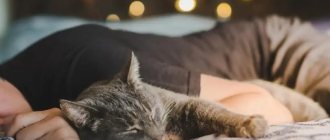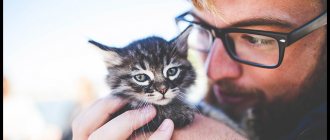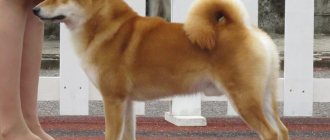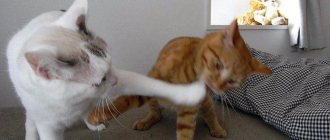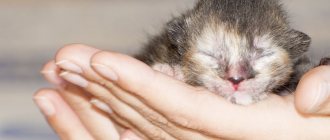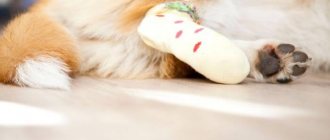Over time, our relationship with cats changed... There was even a time when people burned them at the stake (along with “witches”) - believing that they were in connection with the other world. Being within the framework of superstitions and myths, we avoided and feared them.
But over time, this soulful look, fluffy and beautiful fur, funny mustache and cheerful disposition melted our “cold heart”, and now we live with cats under the same roof.
Lucky people in life: what kind of people do cats love?
It is not uncommon to observe a cat’s inexplicable love for a particular person. It’s surprising when one family member regularly feeds and waters the animal, plays with it and devotes a lot of time, but the cat directs all its love to another person: sleeps with him, purrs. Also often, after buying a kitten, it becomes attached to one member of the household and stays next to him. Even when they grow up, such kittens retain their love and do not exchange it for others.
Showing a cat's love for a person
The reason why this happens lies absolutely not in mysticism or in the special arrangement of the stars. Sympathy is most likely caused by the behavior of a particular person. For example, adult animals like balanced people, with a calm character and a moderate timbre of voice. You can make friends with animals if you catch their gaze and blink several times. Staring will be seen as a sign of threat, while blinking will be seen as peaceful and loyal.
Interesting! It is believed that if a person is loved by cats, it means that his soul is not completely black. Animals, as a rule, try to avoid bad people.
Cat people are considered to be sympathetic, good-natured and a little sentimental people. They also have a sense of responsibility, caring for family and loved ones.
Interesting facts about the psychology and behavior of cats
Cats are unique creatures, but sometimes people find their behavior strange and funny:
- Each cat has his own preferences regarding the appearance of the female. One male may be completely indifferent when he sees a tortoiseshell or red cat near him, and show intense interest when he meets a black cat.
- Many cats at shows get very nervous because of the large number of people and unfamiliar surroundings. These nerves manifest themselves in constant tail twitching. This is easy to deal with - the owner pinches the tip of the tail with his fingers, returning it to a static position, and the cat immediately calms down. The effect is triggered - there is no opportunity to show your nervousness - which means there is no nervousness itself.
- Cats have a sense of humor, but a “peculiar” one. Their favorite pastime is to quietly get close to another cat and scare him with his sudden appearance.
How cats show love to humans
Are there red cats or only cats?
Sometimes it is more difficult to win the affection of a tailed friend than a human. And it is no less difficult to recognize this sympathy, so all owners should know how cats show love for their owner.
How cats show warm feelings towards their owner
He rolls from side to side at your feet
The animal rolls from one side to the other in front of the owner - this is a clear sign of an attempt to attract his attention. Cats only leave their belly open in front of someone they trust and where they feel safe.
Advice! When keeping pets, do not forget about cleanliness and disinfection. The line tool is able to efficiently cope with this task without harming the pets.
Touching your face and hair
It is quite a rare occurrence for a cat to lick the hair or ears of its owner. But those who find such an honor can be confident in the disposition of their animal. Such care is a sign of friendship and the warmest feelings.
Soft objects crush you or crush you
The most common way cats show love and other feelings is by trampling their paws on their owner or the sofa. In fact, there is no exact reason for this behavior, but there are a number of assumptions.
- This is how the cat shows its rights to the territory or, in fact, to the person. The pads of its paws contain glands that, when in contact with surfaces, leave an odor on them.
- Such movements calm the animal. A cat can produce them to relieve stress or show its good disposition.
- Make yourself comfortable. It is generally accepted that wild cats made the bedding in the nest softer with such movements. Households can treat a person very pragmatically, lying on him in search of warmth and comfort.
The cat shows you its furry butt
This behavior of the animal often causes bewilderment among people - why does the pet raise its tail and turn away from its owner. In the language of cats, this is how they show their affection and trust. Cats don’t show love to just anyone like that, which means the person is in good standing with them.
Kisses and licks
If a pet licks a hand or other part of the body, this is not a hint to wash it. This is how cats show love and affection. Their wild ancestors lick every member of their feline pride, while their domestic ones include their owners in their family.
The desire to be close as a way to show love for a person
The desire to be close
Despite the fact that cats have long been assigned independence from humans, many of them simply need to be close to their family members. Accompanying him around the apartment or sitting next to him on the sofa are all ways for a cat to say I love a person, to express a tender and affectionate attitude towards him.
Interesting! It is believed that cats sense approaching death and try in every possible way to leave the house.
Jealousy
This feeling is also characteristic of domestic felines. At the same time, they can be jealous of other animals, guests, visiting friends, and even their phone or tablet. More precisely, to everything that the beloved owner spends his attention on.
Important! The consequence of jealousy can be an overturned flower pot, a broken beautiful vase or a Bohemian set - something that will “switch” a person’s attention.
Caresses and “rough” licks
Licking the owner is the highest cat love, which was instilled from the very birth of the kitten. The mother cat licked her kittens, helping to clean them up. Having matured, the cat can lick the closest and closest family member.
Licking the owner is the highest measure of love
Light nipping
It is quite easy to distinguish between light friendly biting and aggression. Cats rarely use this method. It is also a sign of friendship and sympathy.
Head butting
A cat and cat can express love by slowly butting their owner's head. During this procedure, the animal transmits some of the pheromones, thus expressing the highest stage of trust.
Sleeping on clothes
Many animals prefer to sleep not in their own bed, but on the clothes of one of their family members. This behavior allows them to smell the owner, which calms them down. Therefore, you should not chase your cat away from things, because she is drawn to a feeling of closeness, comfort and safety.
But why do cats love us?
- We are an "inexhaustible" source of food and goodies . Cunning people can concoct such an unfortunate face and peer into the cutlet with sad eyes that the hand itself is tempted to give the delicacy to this “poor and hungry” creature. Our empty stomach will not say “thank you” to us, but a grateful look full of love will warm us all day.
- We are warm and big . You can warm all four paws, tail, ears about us. But by the way, why waste time on trifles, cats can drown in our arms and warm up completely. Yes – the role of the “warmer” is mutual.
- Affection – we give cats incredible pleasure when we play with them or scratch them behind the ears and cheeks. Who doesn't love affection and care? So our pets feel comfortable and safe next to us.
It turns out that living together under one roof, we give each other love, care, warmth and respect. We are “indispensable” for cats, and they are “indispensable” for us. So let's not spoil this idyll.
Should you kiss your cats?
Guarded in a dream: why do cats sleep near their owner’s head?
Feeling love for their tailed friends, people treat cats like humans. They allow pets to sleep under a blanket, try food from their own plate, kiss and much more. However, most of this love can have a negative impact on both parties.
Signs of love from pets
It is worth excluding this manifestation of feelings for several reasons:
- There are many microorganisms on cat fur that you will have to come into contact with. While you can wear a special collar to get rid of fleas and ticks, you can’t get rid of microscopic organisms that way. These can be lichen, staphylococcus, fungi, salmonella and others.
- Allergic reactions can also develop from close contact with animals.
- The owner runs the risk of contracting rabies if a cat goes outside without vaccinations and is then greeted with kisses and close hugs.
- Also, a free-ranging cat can become a carrier of dangerous viruses that are spread by mice, birds and other animals with which they may have come into contact.
Interesting! Kisses themselves are not pleasant for cats. They regard them as a sign of aggression, so they try to avoid such contact by any means.
Cats and love are close concepts for the owners of these pets. For harmonious communication with them, it is important not only to devote time to them and provide them with the necessary care, but also to be able to “read” their habits. Perhaps, at first glance, unusual and strange behavior may indicate a favorable attitude towards the owner.
Cat tongue or how to understand a pet
Considering the peculiar and extremely capricious nature of cats, it is quite possible to make life with them comfortable for both parties if you learn to understand pets, recognizing their mood and desire by certain postures and sounds made:
- Hisses - warns that he doesn’t like how they treat him (read more about why cats hiss).
- Snorting - wants to divert attention from himself, in the same way he can express confusion and surprise.
- Grumbles - shows an extreme degree of dissatisfaction.
- Rumbling in a low range - ready for his own defense, which means he is extremely wary of the current situation.
- “Meow,” said briefly, is a greeting.
- Smacks his lips or clicks his teeth - he shows the instinct of a hunter, but at the same time he shows irritation that he was unable to catch the prey.
- He purrs - he is absolutely satisfied with his position.
- “Meow”, played with a slight hoarseness, shows gratitude and good attitude.
Poses and their explanation:
- Sits, covering his paws with his tail - complete moral and physical relaxation, absolute calm. In this position, it can watch with interest its owner or what is happening outside the window.
- Shifts from paw to paw, rubs against a person’s legs - this is how a pet greets its household members.
- Rubbing its head against a person’s legs or his face shows openness and complete disposition towards the owner.
- The back arches - it’s scary.
- The fur stands on end, the paws straighten sharply, the body is raised high - it feels threatened.
- Lying with his stomach up is a posture of thoughtfulness, dozing.
- The tail is raised up - the animal is calm and friendly.
- A ruffled and drooping tail is an expression of complete confusion.
- The tail hanging down and tapping it on the floor is a sign of fear.
- It intensively wags its tail in different directions, the tip touches its paws - it is in an extreme state of irritability and can behave aggressively at any moment.
What the eyes will tell you. You can also understand a cat’s mood by the expression in its eyes:
- Eyelids are half-closed - relaxation, a feeling of peace and absolute calm.
- Eyes wide open - a manifestation of incredible interest.
- The pupils are greatly dilated - fear and fright.
- Looking away to the side - she is ready to obey and do what her owner wants from her.
- Looks into a person's eyes, ears directed forward - interest, desire to communicate or receive a treat.
Knowing how a cat shows emotions, you can predict its desires and needs, assess your pet’s readiness to make contact or its desire to be alone.

